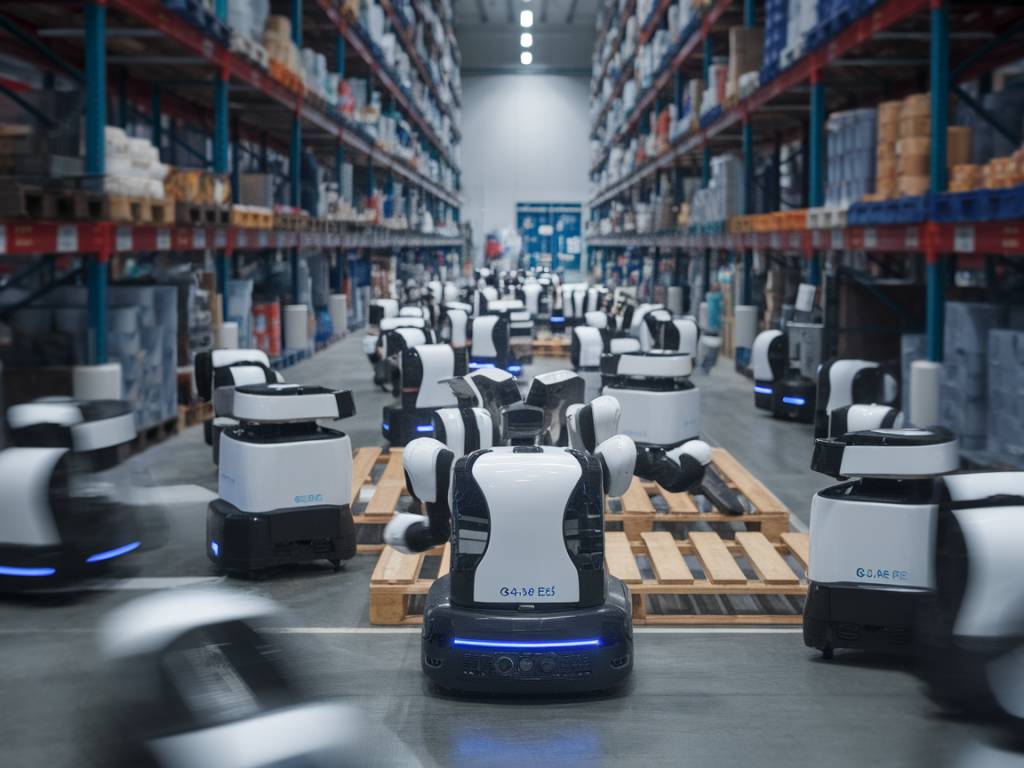What is Swarm Robotics in Warehouse Automation?
Swarm robotics refers to the use of multiple autonomous robots that communicate and cooperate to perform complex tasks. Inspired by natural swarms like ants or bees, these robots operate using decentralized control systems. Instead of one central intelligence dictating commands, each unit makes local decisions based on its environment and interactions with neighboring units. In warehouse automation, this model allows operations to scale rapidly without sacrificing efficiency.
The integration of swarm robotics in warehouse logistics is a growing trend, especially in scalable systems. Driven by the increasing demand for faster deliveries, flexible fulfillment models, and real-time responsiveness, swarm-based models offer a lightweight solution to complex supply chain challenges. As edge computing and AI capabilities progress, these collaborative bots are becoming an accessible and cost-effective alternative to traditional fixed automation systems.
Why Swarm-Based Systems Outperform Traditional Warehouse Automation
Conventional warehouse automation relies heavily on monolithic systems—conveyor belts, fixed robotic arms, and central decision hubs. These systems are powerful but lack the agility required to react instantly to dynamic changes in workload or inventory distribution. Swarm robotics introduces flexibility, resilience, and scalability through distributed intelligence and mobility.
Key advantages of swarm robotics in warehouse environments include:
- Resilience to Failure: If one robot in the swarm fails, others can adapt and compensate in real-time.
- Decentralized Autonomy: There’s no need for a complex control tower. Decisions are made locally and efficiently.
- Easy Scalability: Need to increase operational capacity? Simply add more robots to the swarm without disrupting the core infrastructure.
- Dynamic Path Planning: Swarm robots continuously optimize their movement, avoiding congestion and reducing delivery latency.
- Energy Efficiency: With optimized routes and task balancing, battery consumption is minimized across the entire fleet.
This decentralized, resilient structure makes swarm robotics especially suitable for ecommerce fulfillment, high-volume sorting operations, and dynamic inventory handling tasks.
Key Technologies Behind Swarm Robotics in Logistics
The performance of swarm robotics in warehouse automation depends heavily on several interrelated technologies. Understanding these elements is crucial for evaluating system capabilities and integration possibilities.
- Machine Vision and Sensors: Each robot is equipped with cameras, LiDAR, or ultrasonic sensors to interpret its environment and detect objects or obstacles.
- Edge AI and Local Processing: Localized computing power enables on-device decision-making without constant data exchange with the server.
- Wireless Mesh Communication: Robots must communicate efficiently, usually over Wi-Fi or BLE mesh networks, to coordinate movement and share environmental data.
- Swarm Algorithms: These proprietary or open-source algorithms govern how robots allocate tasks, prioritize objectives, and respond to environmental changes.
- Collaborative Mapping and SLAM: Simultaneous Localization and Mapping (SLAM) allows bots to create a live map of dynamic warehouse environments and share updates in real time.
Vendors such as Kiva Systems (acquired by Amazon), inVia Robotics, and Locus Robotics are developing sophisticated swarm-based platforms, leveraging AI and real-time data exchange to transform warehouse operations.
Applications of Swarm Robotics in Warehouse Operations
Swarm robotics can be deployed across a wide range of mission-critical tasks within modern warehouses. Their ability to handle various assignments simultaneously while managing dynamic inventory flow makes them valuable assets in high-demand environments.
- Order Fulfillment: Swarm robots can retrieve items from shelves and deliver them to packing stations, balancing workloads as they go.
- Inventory Replenishment: Robots can monitor stock levels and independently restock shelves, particularly in Just-in-Time inventory models.
- Sorting and Routing: Packages of varying sizes can be automatically sorted and routed through intelligent collaboration among bots.
- Dynamic Warehousing: In decentralized or pop-up warehouses, swarm robots facilitate fast setup and agile scaling without needing fixed infrastructure.
Whether used in micro-fulfillment centers or massive distribution hubs, these autonomous agents contribute to reducing lead times, improving picking accuracy, and increasing throughput per square meter.
Challenges in Adopting Swarm Robotics for Scalable Logistics
Despite its potential, integrating swarm robotics into existing warehouse systems presents several challenges. Businesses must carefully evaluate these considerations before moving forward with deployment.
- Integration with WMS: Swarm robotics systems must integrate seamlessly with Warehouse Management Systems (WMS) and ERP platforms to ensure operational harmony.
- Workforce Adaptation: Human workers need to be trained to interact safely and efficiently with autonomous robots on the warehouse floor.
- Real-Time Communication Bottlenecks: High-density networks and real-time task reallocation require robust, low-latency communications infrastructure.
- Initial Investment: Although scalable, the initial cost of swarm robot hardware and the supporting infrastructure can deter small enterprises.
- Regulatory and Safety Compliance: As more robots operate autonomously, ensuring safety, redundancy, and compliance with labor standards becomes crucial.
Nonetheless, many of these challenges are diminishing as technology matures and costs decline. Modular systems and Robotics-as-a-Service (RaaS) models are creating more accessible pathways to adoption.
Future Outlook: Swarm Robotics in the Supply Chain Ecosystem
The integration of swarm robotics will not only redefine internal warehouse processes but also extend throughout the entire supply chain. Their autonomous and networked nature makes them ideal tools for adaptive manufacturing, last-mile delivery in urban logistics hubs, and inter-warehouse coordination.
In fact, industry experts foresee swarm robotics playing a key role in predictive logistics—leveraging data from IoT sensors, customer behavior, and warehouse signals to pre-position products closer to anticipated demand. This level of proactive operation is only achievable through a high degree of autonomy and coordination—traits inherent to swarm systems.
As 5G networks, decentralized AI, and real-time digital twins become commonplace, the performance of collaborative robots will continue to improve. Companies investing in swarm robotics today are not just optimizing current operations—they’re paving the way for a truly intelligent, scalable supply chain.
In conclusion, the fusion of swarm intelligence and warehouse automation offers an unprecedented opportunity for businesses to scale effectively without compromising agility. From high-throughput ecommerce operations to agile urban fulfillment centers, swarm robotics holds the key to operational excellence in the logistics of tomorrow.

